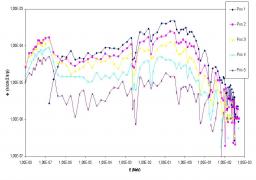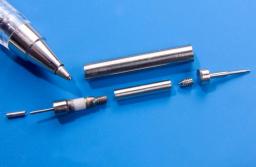
Energy distributions of neutrons simulated by Monte Carlo and "seen" by detectors. Each distribution corresponds to one position along the beam axis in the central rod of the target.
Neutrons which are generated inside the target by spallation reactions are detected thanks to ionisation detectors called fission chambers. Neutron fluxes as high as 1014 n/cm2/s can be measured with these very small detectors (few millimeter in diameter). Placed at different positions inside the central rod of the target they are used to characterise the inner neutron flux and to study the spectral variations depending on the propagation of the neutron in material: larger distances the neutron has to travel lower will be its energy due to successive collisions with surrounding materials. To these internal detectors, 3He detector has been added closed to the target head, to measure delayed neutrons emitted several seconds after the beam stopped.
These measurements are completed by very detailed Monte-Carlo simulations taken into account all the geometry of the target.
The neutron detector is made of height fission chambers and a mechanical structure. The acquisition system, also developed at Dapnia, measures currents induced by fission from 500 nA to 100 mA with accuracy better than few nanoamps for applied voltage up to 400 Volts. Moreover nine activation monitors (foils) were also placed inside the detector.
The big difficulty was to realise a neutron detector able to work in high temperatures varying from 230°C up to 600°C, resistant to radiations and without any possibility to access during the irradiation. Moreover, the weak signal should have been propagated over several meters of cables in a very radioactive nuclear environment.
One of the big challenges for engineers was to deploy techniques close to those used in watchmaking (micro-mechanics) in a nuclear environment. Indeed engineers had to integrate 8 microscopic fission chambers in a long (5 meters) but small diameter tube (less than 1 centimeter).

Microscopic fission chambers: they contain deposit of uranium 235, or neptunium 237, or américium 241. Two of them are are surrounded by a gadolinium shielded of 200 µm in thickness to absorb thermal neutrons. These chambers were developped, in collaboration with DEN/DER/SPEX and Photonis, to sustain high temperatures. They have been tested in the high flux reactor of ILL (Grenoble).
